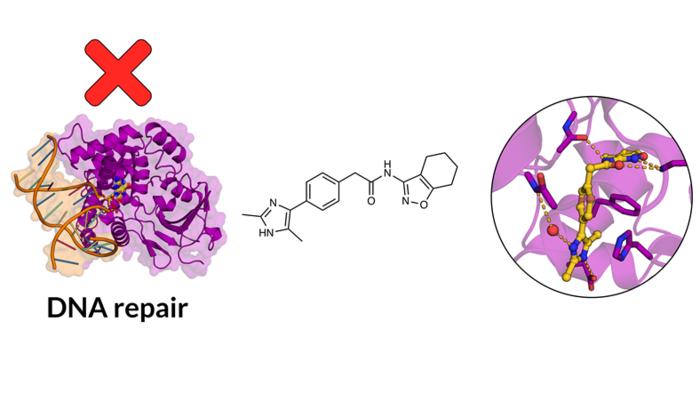A groundbreaking study published in Nature Communications reveals the immense potential of computer algorithms in the quest for new anti-inflammatory drugs. This research signifies a major evolutionary step in drug development, as scientists strive to sift through an astonishingly vast chemical space to identify promising drug candidates. The sheer scale of the task is highlighted by the incredible figure of approximately ten sextillion possible molecular alternatives, which was explored within this study. As the world of medicinal chemistry races to keep up with exponential growth in computational capabilities, researchers are meticulously examining how these advanced technologies can expedite drug discovery processes.
The study’s focus is on OGG1, an enzyme crucial for repairing damaged DNA, which is fundamental for maintaining cellular health. Inhibitory molecules that can bind to OGG1 may lead to breakthrough treatments for inflammatory diseases and other serious health conditions. The research team, comprising experts from renowned institutions including Karolinska Institutet and Stockholm University, utilized advanced computer modeling to design a multitude of molecules intended to interact with the enzyme. By synthesizing over a hundred unique compounds, researchers have initiated a revolutionary form of drug design that leverages computational power to streamline the discovery process.
Employing commercial molecular libraries provided the initial resources for the research, with computational programs designed to sift through billions of readily accessible molecules. Harnessing the capability of supercomputers, the team meticulously analyzed binding affinities to the OGG1 enzyme. Remarkably, this search yielded functional molecules that exhibited significant inhibition of the enzyme’s activity. This success bolstered the researchers’ confidence, leading them to explore the potential of expanding their inquiry beyond commercially available substances.
The new computational tool developed by PhD student Andreas Luttens unlocked the possibility of exploring a staggering number of synthetic molecules. This system provided the researchers with the unprecedented ability to generate a database of highly diverse molecular candidates, significantly broadening the scope of their search. Enabling the examination of a staggering ten sextillion molecules reveals the groundbreaking nature of this research; it illustrates the emerging intersection of computational chemistry and practical medicine.
As the researchers detailed their findings, they noted that while the power of computation presents new opportunities, the reality of producing these engineered molecules remains a challenge. The ability to theoretically design potent inhibitors does not guarantee that these substances can be synthesized or developed into front-line treatments. Consequently, there is an urgent need for advancements in synthetic methods and collaborative frameworks among medicinal chemists and computational biologists to ensure that drug candidates transition from computer models into real-world applications.
The implications of this study reverberate across the pharmaceutical industry, suggesting that drug discovery could soon be transformed by integrating sophisticated algorithms with traditional laboratory work. The potential for this technology to speed up the drug development timeline while simultaneously reducing costs may reshape therapeutic strategies for various diseases. As scientists aim to model disease states through computational simulations, this technological breakthrough may facilitate the development of drugs that have previously taken years to identify and produce.
Moving forward, it is clear that interdisciplinary collaboration will be pivotal to maximizing the efficacy of these techniques. As computational methods evolve and deepen our understanding of molecular interactions, researchers who can effectively combine computational insights with empirical findings will drive the future of drug discovery. The synergy between computational power and medicinal chemistry could signal the dawn of a new era in pharmacology, where the rapid synthesis of innovative anti-inflammatory drugs may soon become routine.
As expectations for pharmaceutical solutions continue to rise, the necessity for robust, efficient, and scalable drug discovery methodologies remains paramount. This study lays important groundwork for future research in molecular design, emphasizing the need for continuing advances in both algorithmic approaches and practical applications. Moving forward, it will be crucial to investigate how these promising inhibitors can be effectively tested and brought into clinical settings.
Through the lens of this transformative research, we witness the promise of computational models not merely as theoretical constructs but as foundational tools for optimizing the process of drug discovery. As the world stands on the brink of a scientific revolution in medicine, it is exciting to envision the future landscape where computational chemistry and experimental research converge to create novel treatments that improve the quality and longevity of human life.
By exploring new methods of research that evolve with technology, scientists will be poised to address the complexities of disease with unprecedented speed and precision. The ongoing integration of computational strategies in drug discovery heralds a future in which we harness the full potential of innovation to create profound impacts on health outcomes globally.
Subject of Research: Drug discovery, computational chemistry
Article Title: Harnessing Computational Power to Discover Anti-Inflammatory Drugs
News Publication Date: February 18, 2025
Web References: Nature Communications
References: Luttens, A., Vo, D.D., Scaletti, E.R. et al. Virtual fragment screening for DNA repair inhibitors in vast chemical space. Nat Commun 16, 1741 (2025). DOI: 10.1038/s41467-025-56893-9
Image Credits: Andreas Luttens
Keywords
Computational modeling
Protein analysis
Antiinflammatory drugs
Drug design
Algorithms
Drug candidates
Enzymes
Protein design
Enzyme inhibitors
Tags: advanced molecular modeling techniquesanti-inflammatory drug developmentcomputational capabilities in biomedicinecomputational drug design methodscomputer algorithms in medicinal chemistryDNA repair mechanisms in healthdrug candidate identification strategiesdrug discovery breakthroughsinnovative research in pharmacologylarge-scale molecular screeningOGG1 enzyme inhibitorsvast chemical space exploration





